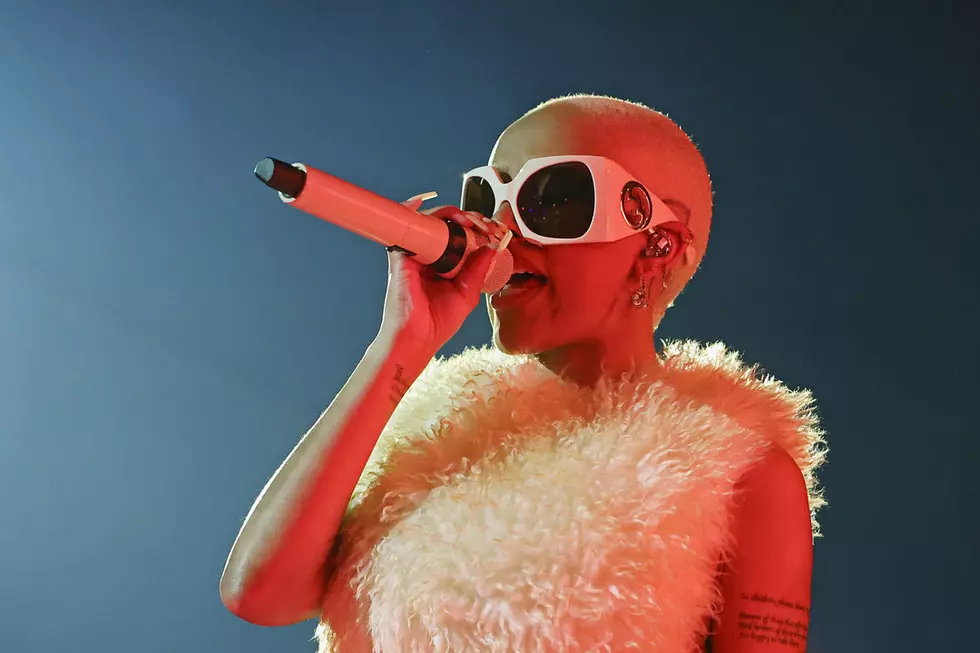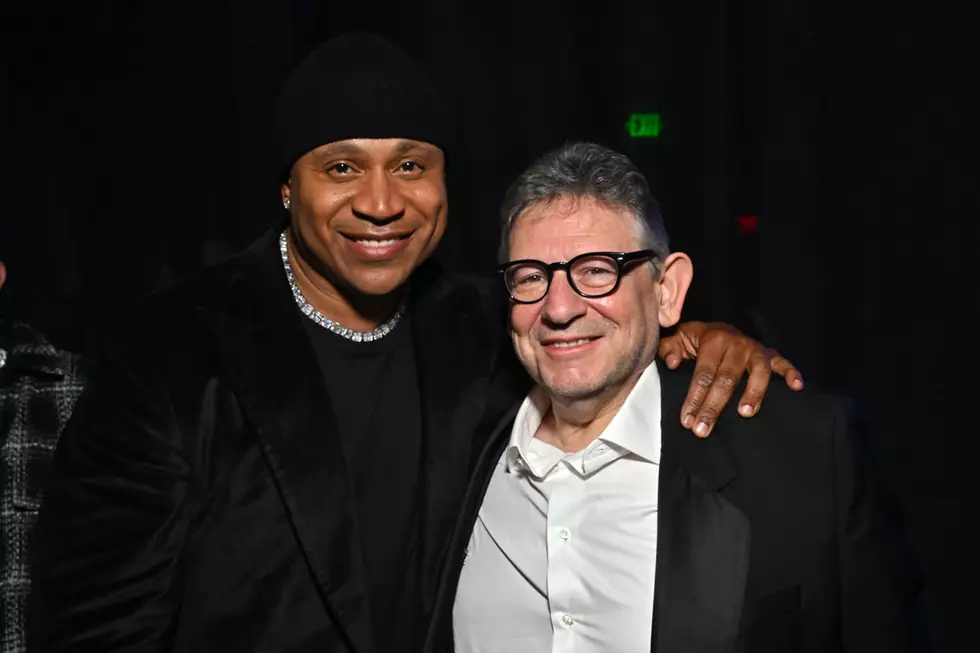
G-Eazy Solidifies His Spot in Hip-Hop With “No Limit”
Illuminate
G-Eazy aims to find his place in hip-hop while discovering who he really is.
Words: Sowmya Krishnamurthy
Images: Travis Shinn
Editor’s Note: This story originally appeared in the Spring 2017 issue of of XXL Magazine, on stands now.
“The magnificent attitude of not giving a damn…” writes F. Scott Fitzgerald in The Beautiful and Damned, a story about how being absorbed in excess, decadence and selfishness ultimately leads to downfall. A cautionary tale written in 1922, the novel resonates today with G-Eazy. “Everybody was drinking too much,” he says. “Everybody was going out and partying. What they didn’t know was the Great Depression was about to hit and they all got smacked in the face. I think there’s a similar thing going on now, especially in my world.”
The rapper pauses, letting the point sink in. His fourth studio album, The Beautiful & Damned, released this past December, is a rumination on the price of fame. The 28-year-old is riding high. His single “No Limit” featuring A$AP Rocky and Cardi B has peaked at No. 2 on Billboard’s Hot 100 chart. In the following months, the track will have amassed more than 196 million streams on Spotify and over 26 million spins on SoundCloud—and counting. It’s ubiquitous on the airwaves. For the first time in his career, he has a bona fide hip-hop hit. The album debuted at No. 3 on Billboard’s 200 chart with 122,000 units sold (68,000 in traditional album sales). Things are progressing on the personal front, too. He’s dating singer Halsey, the self-described Bonnie to his Clyde. Life is looking up, but G-Eazy is scared he’ll crash and burn. “At what point are you spiraling out of control?” he asks.
It’s an early October evening at The Clocktower in New York City. Formerly the landmark of the Metropolitan Life Insurance Company Tower, it has been transformed by Ian Schrager—the man behind the famed Studio 54 nightclub—into a casually chic hotel. There’s an air of vintage glamour here. The vibe is somewhere between cozy speakeasy and private club, amid dark mahogany wood paneling and wainscoting. A billiards table sits below a glowing purple chandelier. G shoots a few rounds in between photo takes. Beneath the crown moldings hang framed photographs of famous rock ’n’ roll icons from years gone by; Madonna, David Bowie and Grace Jones. The bar—where Halsey and G-Eazy’s crew are currently holed up—is made entirely of 24k gold leaf and serves meticulously-crafted cocktails with hipster ingredients like elderflower syrup, fresh dill and smoke salt solution. It’s the kind of place where F. Scott Fitzgerald’s characters would want to hang out. G-Eazy is right at home.
Gerald Earl Gillium is not a typical rapper upon first look. Often dubbed the “James Dean of hip-hop,” he has a handsome-yet-brooding visage similar to the Rebel Without a Cause actor. Standing at 6 feet 4 inches tall, his features are chiseled and his longish, dark hair is usually slicked back. He’s in a black T-shirt from the Supreme Scarface collaboration and cropped trousers. A wallet chain hangs at his side. He appears more 1950’s Greaser than rapper but looks can be deceiving. He’s paid his dues. “If you looked at me like I’m an arrogant, pompous asshole you’d be like, ‘I don’t like that guy,’’ G-Eazy explains. “I don’t think people know how vulnerable I am.”
The Oakland native started his career as a bedroom producer in his teens. “Just me and my friends. I would send MySpace messages to well-known local artists and not hear back,” he laughs, pointing to Bay Area artists like Mistah F.A.B., Keak Da Sneak and The Team as recipients of his digital hustling. In 2008, at the age of 18, he moved to New Orleans to study Music Industry Studies at Loyola University. It was here where he met his two managers,
Jamil “Big Juice” Davis and Matt Bauerschmidt, and rapping became his focus. “I was recording in my dorm room. I had a little set-up,” he remembers. “My neighbors hated me on every side of the wall. I was pressing up my CDs, trying to sell them.”
Timing was on his side. SoundCloud began to gain momentum with underground artists and G-Eazy’s music started to circulate beyond his dorm room. He and his managers maxed out their respective credit cards—for a total of $2,000—to shoot the video for his track “Runaround Sue.” The 2010 song about jilted love was ultimately taken down from YouTube due to copyright infringement issues (“We sampled [the] old 1960’s song that never got cleared”) but its impact was made. That year, G scored an opener slot on tour with Drake. He downplays the significance in retrospect. “We were driving around, following their tour bus,” he laughs. “They would let us perform right after the doors opened. I’d have a little 10-minute slot right before the other opener, before the other opener, before the other opener.” A Drake look, no matter how minor, would prove significant. Other cosigns would follow. He considers OGs like Jadakiss, E-40 and Busta Rhymes—who dapped him up after his 2014 BET Hip Hop Awards cypher—among his supporters as well as his sounding boards. “You know, respect from those I respect I always value—people I grew up listening to,” G-Eazy states. “That’s who I check in with and play my music for and get feedback from.”
In 2012, G-Eazy independently released Must Be Nice, which peaked at No. 33 on the Billboard R&B and Hip-Hop chart. Continuing his self-funded strategy, the rapper took all the money that he earned to bet on himself. He spent $100,000 that he made from shows and by selling music on iTunes to shoot three music videos leading into 2014’s These Things Happen. By the time RCA Records wanted him to sign, he had proven himself a formidable investment. “I had gotten the ball moving on my own,” he says. “When the labels came, I was able to get the deal I wanted because the ball was in my court. I had leverage.”
His 2015 album, When It’s Dark Out, marked success on a large scale. The release debuted at No. 5 on the Billboard 200 Albums chart and No. 1 on the Billboard Rap & Hip-Hop chart. The effort went platinum, bolstered by “Me, Myself & I” featuring Bebe Rexha. An introspective but infectiously melodic hit, it’s gone four times platinum in the U.S. and has over 329 million views on YouTube. He’s toured extensively, earning a grassroots fan base, including opening up for the Drake vs. Lil Wayne tour in 2014, and co-headlining with Logic for The Endless Summer Tour in 2016. “I spent like, the better part of five years on the road,” G says. “For a while, I didn’t even have an apartment. I was renting an apartment I didn’t get to spend much time in. So finally when that tour ended, in September of [2016], I moved into a house.” His first big purchases: buying his first home in Los Angeles and getting his mom a Jeep Cherokee. “She had a used one when we were little kids,” G-Eazy recalls. “She’s always liked that car.”
It’s the best time for G-Eazy—professionally and personally winning—but the kid from Oakland worries that his new Hollywood life has Hollywood consequences. “I chased this fantasy,” he admits. “All these years later, I ended up here. Did I take a wrong turn somewhere? Did I become somebody I didn’t want to be when I moved to Hollywood?” That theme—the duality between G-Eazy, the artist, and Gerald, the man—is at the forefront of The Beautiful & Damned. An opine on celebrity lifestyle and its consequences, it’s a double album with one side devoted to each aspect of him—the good vs. the bad. “The internal battle between G-Eazy vs.Gerald and you know, this whole self-destructive rock star lifestyle.” On the title track, he explains his struggle: “When you move this fast as I’m movin’/All the toxic things that I’m using/All the substances I’m abusin’/All the sex, and the drugs, and the boozin’/ The decision is mine for the choosin’/But I can’t understand what I’m losin’.”
G-Eazy says that alcohol and drugs are his vices as is sex, without going into further detail of his predilections. The show, the after-party and the after-after-party lifestyle is intoxicating. There’s a fine line between recreation and addiction. He describes the cycle: “I would drink before I go on stage or drink when I’m in the studio, I tell myself it loosens me up and helps me perform better.” He speaks thoughtfully, measuring his words. “I’ll drink at the after-party—because it’s all around me—to the point where I’m blacking out a lot of these nights. I’m telling myself, ‘I need this to perform.’”
Aside from the “massive headache and nursing this hangover away in time to do it all again,” there have been intangible consequences. He notes a romantic relationship on the album that hit a sour note. “You break relationships because your life is so different from those you started with or your family or your friends back home or old girlfriends,” he says. “You become this person who’s lying and cheating and so distant.” As a response, he tries to go home—to both Oakland and New Orleans—as much as possible to see family and friends. It’s a trade-off he constantly grapples with. Incidentally, it was friend and mentor Too $hort who put him on the game: “[He said,] ‘Always go back home and never get lost in the sauce,’’’ G breaks down. “‘Never let this get the best of you.’” It’s not easy. He wants to do right by his day-ones but there’s the persistent, nagging feeling that sleeping on opportunities gets you slept on. “It’s hard to find the time when you work so hard and put yourself in the position to gain opportunities, to gain exposure or play shows or pick up these bags. How do you justify saying no because you have to go home and spend time with your grandma?”
Four months later, these thoughts still weigh on G’s mind. We’re in his Los Angeles home, a Tuscan-style villa built into the hills of a part of the city literally called Hollywoodland. It’s early February and while the rest of the country laments a long winter, it’s warm enough here to take a dip in his pool. G is calm yet giddy, geeked over his first XXL cover. Not too bad for a guy who was passed over being a Freshman—a few times, by his count. We sit in his lower-level studio where much of his album was recorded. He’s bathed in red neon light from a sign that reads, “When It’s Dark Out.” This is the spot that rapper friends spontaneously drop by to record and chill. Downhill, there’s a plethora of nightlife. It’s easy to see how the lines between normalcy and celebrity can blur here. “There’s this whole dark side of L.A. that we all know about. The effects of moving out here...The superficial people. The opportunists. The shady people. The industry people,” he says. “The Instagram girls. The struggle rappers. Everything in between.”
Gerald ponders how to find balance. But G-Eazy understands that there’s allure to his persona. His fun, carefree side appeals to those that live the life (or for those that just want to vicariously experience it through him). “No Limit” is a testament to his ability to get the party lit. It’s not surprising that brands are increasingly drawn to work with him. In June of 2017, the rapper was named partner and Co-Creative Director of Stillhouse whiskey. Last August, he headlined Bud Light’s Dive Bar Tour, along with Cardi B and Halsey, in New Orleans. “G’s style is something that the brand was excited to tap into for Dive Bar Tour,” says Shana Barry, Sr. Experiential Manager, Music & Entertainment for Bud Light. “G-Eazy’s music talks about friendship and having a good time…a natural fit to work together.”
G is more than just a pretty face. In January, he severed ties with H&M. He had a forthcoming capsule collaboration with the retail giant, but after it featured a separate advertisement showcasing a young Black child modeling a hoodie emblazoned with the phrase, “Coolest Monkey in the Jungle,” G harangued the retailer for the tone-deaf spot. “I can’t allow for my name and brand to be associated with a company that could let this happen,” he shared on Instagram. “Whether an oblivious oversight or not, it’s truly sad and disturbing that in 2018, something so racially and culturally insensitive could pass by the eyes of so many.”
The controversy caused The Weeknd to cut his ties with H&M but Nicki Minaj, another face of the brand, hasn’t publicly done so. What prompted G to speak out? “I mean, of course, it was a huge opportunity that I was excited about but at the end of the day, none of that matters,” he tells. “I put a price on right and wrong. As an artist, you have a huge influence, a huge reach and a huge voice. In times like that, it’s not even a conversation,” he says. “You just have to do what’s right. You are what you put your name on.”
For G, The Beautiful & Damned is his seminal release. “I put my all into it,” he tells. “I feel like I want this to be my defining moment.” He cites the importance of the third album in solidifying a rapper’s career. It’s a make-or-break moment and can separate the flukes from the careerists. “I studied my heroes,” he continues. “I studied my idols like Kanye West, Eminem, Drake, and if you follow their careers, their third album was a defining moment. And that’s what I want. A huge leap forward.” Jamil “Big Juice” Davis, who’s known the rapper for a decade, agrees. “We’re gonna take him to the next stratosphere with this album. He put his heart and soul into this.” Davis says that “No Limit” is a tipping point. “You have no idea how many people said, ‘I never fucked with G but this ‘No Limit’ record, I fuck with G.’ That’s crazy to me.”
The existential crisis between Gerald and G-Eazy isn’t solved by the end of the album. It isn’t solved when we part ways in Los Angeles. There isn’t a nice period and G’s not sure how his two identities can coexist—if at all. He’s still figuring it out. He’s a party boy that’s in a committed relationship. He’s a rager that’s socially conscious. He’s hopeful he’ll strike a balance between the man he was, the man he is and the man that he wants to be. G knows how he’d like his story to end: “At some point, Gerald has to win. Gerald can’t let G-Eazy kill him.”
Check out more from XXL’s Spring 2018 issue including our cover story with 21 Savage.
See Photos of G-Eazy's XXL Magazine Spring 2018 Cover Shoot
More From XXL









